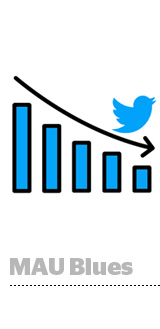
Twitter’s got a new metric for Wall Street to chew on – monetizable daily active users (MDAU) – and something to hide: the fact that monthly active user growth is on the decline.
Starting this quarter, Twitter will report the number of logged-in users it’s actually able to make money on rather than what CFO Ned Segal called “a more expansive metric that includes people who are not seeing ads.”
“We want to align our external stakeholders around one metric that reflects our goal of delivering value to people on Twitter every day and monetizing that usage,” Segal said on the company’s Q4 2018 earnings call Thursday.
To that end, Twitter shared its DAU count (sorry, monetizable DAU count) for the first time, which clocked in at 126 million, a 9% year-over-year increase.
The decision to retire straight-up DAUs, however, calls attention away from Twitter’s MAU decreases. Monthly active users now stand at around 321 million, down 9% year-over-year and by 5 million from Q3. Twitter will stop sharing MAU numbers for both the United States and international markets after Q1 2019.
Twitter attributed its MAU loss to a hodge-podge of factors, including reduced email notifications, initiatives to weed out trolls and bots and changes the company made to comply with the General Data Protection Regulation in Europe.
But hey, look over here at our newly-dubbed monetizable DAUs, Twitter told investors – they’re on the upswing.
(In a similar vein, Facebook recently introduced a new metric that counts people across all its apps, claiming that number better reflects its deduplicated audience – though it also helpfully obfuscates losses for any single property.)
Around 2015, Twitter often talked about the potential of its logged-out audience, but you don’t hear much mention of them anymore. Today, Twitter is prioritizing its more active user base, and that requires ongoing investment to detoxify conversation on the platform and encourage engagement. Twitter claims that its efforts are paying off, with a 16% YoY decrease in abuse reports and the ability to be three times more effective with enforcement on reported content.
“Health is the number one priority both from a resourcing and a mindset perspective,” Segal said.
In Q3, Wall Street rewarded Twitter for its efforts to kick out the trolls and create a more civil environment, and, despite a dip in MAUs that quarter, the stock went up.
The same was not true in Q4, however. Although Twitter recorded its fifth straight quarter of profitability and total revenue increased 24% over last year to $909 million – including a 23% uptick in ad revenue to $791 million – the stock tumbled on cautious revenue guidance.
But Twitter is optimistic about its outlook. The platform is still more demand constrained than it is supply constrained, meaning advertisers aren’t spending as much as they could be.
The opportunity, Segal said, is to flip that equation with better ad formats and better ad relevance, which will both continue to be top investment areas at Twitter in 2019.
This post was syndicated from Ad Exchanger.


More Stories
Daily Wire Welcomes Perplexity to Advertise on The Ben Shapiro Show
Here’s the Roundup for the Week Ending March 7
Aflac’s Dan Amos Reveals How He’s Successfully Held Onto the CEO’s Job for 35 Years